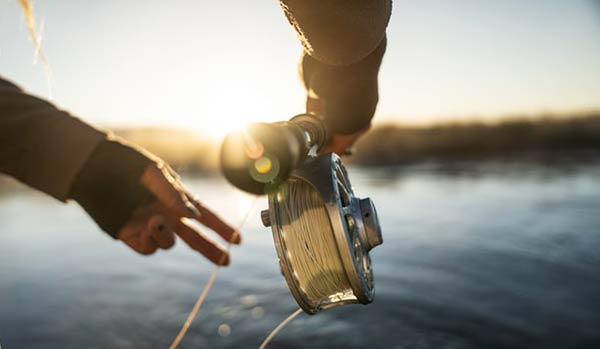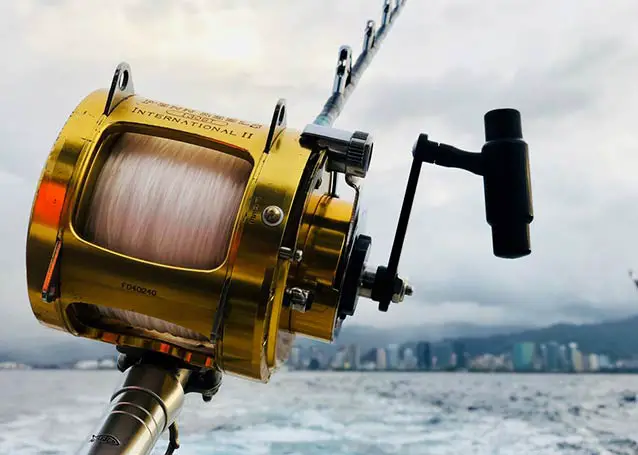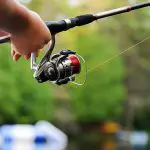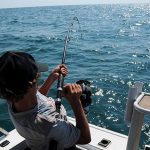Purchasing a new fishing reel is a daunting task for anyone new to angling. With so many brands and styles to choose from, it’s easy to become overwhelmed and make a spur-of-the-moment purchase.
It’s important to take into consideration a multitude of factors when purchasing a reel, including the angler’s familiarity with the style, the angler’s skill level, the intended use, and the environment it will be used in.
One of the most commonly used reels on the market is an Open Face reel.
Open Face reels or spinning reels are utilized in fishing everything from saltwater to freshwater and all that is between. It’s a reel with a stationary spool for line storage that is not closed off.
The benefits of this Rod include a design that helps prevent backlash and causes the line to cease unwinding once a cast is concluded.
Contents
Key features
Key features of Open Face reels include:
- Spool: the centerpiece of the real witch the line is wound tightly against and holds it in place.
- Handle: To force the real back in place, the handle must be turned.
- Line Roller: The guide for the fishing line to be routed from the spool to the rod.
- Drag Knob: the knob which controls the difficulty or resistance against the line coming out of the spool. It is adjustable.
- Reel Foot: the metal or plastic connection that anchors the reel to the rod.
How To Set Up an Open Face Reel
Though this real setup can be a daunting task to beginners, anglers of all skill levels can utilize the Open-Face reel with great success.
When using an Open Face reel, it’s important to follow a step-by-step process from set up to retrieval.
1. Seating
Connecting the real to the rod is the first of several steps to bring your rod and reel combo into action.
The first step is loosening the reel seat, followed closely by securing the reel’s foot inside of the seat. Ensure that it is facing the correct way up the rod, and the reel is set up to your dominant hand.
Once this is confirmed, tighten the real seat back down until there is little to no wiggle or play in its binding.
2. Spooling
When spooling a reel, anglers must take the proper amount of precaution and time to ensure that it is done correctly the first time. This single step can have massive repercussions both good and bad later on.
To begin spooling one’s real, individuals must Open the bell as the first step. Once Opened, a single loop around the reel, followed by an overhand knot in the line are the next steps.
After this first knot, tie a second and place tension on the line until it is tight to the spool. Use scissors, or another cutting tool to trim away any loose pieces of the line.
3. Stringing
Once the line is tied to the spool, close the bail, and begin turning the reel until the number of lines needed is achieved.
When this is complete, grip the line in one hand while Opening the bay along with the other. Thread the tip of the line through the eyelets down the length of the rod.
4. The Knot
Once the line has passed through the rod tip, there should be some sort of lure, islet, or Hook it will attach to.
Thread the line through the lure or hooks anchor point, and begin twisting. After seven twists, return the tip of the line to the original twist and thread through the separation between hook and line.
Once this has been achieved, there should be a secondary loop created from this maneuver. Thread the tip of the line through this and cinch down. Ensure that the nut is tight by gripping both the lure or hook and line and gently tugging. If done correctly, there should be a little give.
5. Drag
The drag knob is an important piece of the reel, which allows you to dictate the struggle against the fish on your terms.
Detention placed on the line, and difficulty with which it comes out of the spool will tire out the fish without requiring as much work from the angler. However, if the drag is set too high, the line may become too tight and snap under the pressure.
To determine proper drag, it’s important to know the pound test of the line small, and the species being angled for. Once this is determined, individuals may put pressure on the line by wrapping a fistful of it in one hand and gently tugging, while the other adjusts the drag. Once it is satisfactory, it should be left alone.
Using an Open Face Rod and Reel
Cast
- Allow over a foot of slack from rod tip to hook.
- Pinch the line and flip the bail.
- Check your surroundings
- Bring the rod directly back from its intended direction.
- Bring the rod forward in the intended direction and release the line.
Casting an Open-face reel can seem difficult to an inexperienced angler. However, with a little bit of practice and attention to detail, it can quickly become second nature.
To begin, allow between 1’ and 1 1/2’ of line to hang from the tip of the rod. With the casting (dominant) hand, place the index finger on the taught line and flip the bail upwards.
Grip the rod firmly with the remainder of the fingers, and check your immediate surroundings for any possible obstructions or snags. Once the check is complete, bring the Rod back in an arcing motion. The further back an individual brings the rod in conjunction with how hard they cast will decide the distance the lure or bait will travel.
Once the end of the backward stroke is complete, swiftly bring the rod forward in the direction you wish to be to go.
Note: for the more experienced anglers, or those who have mastered the Open Face reels cast, mitigating outgoing line can stop cash short of snags or drop the lure or bait in the exact spot intended. Pay attention to the arc and trajectory of the line and tamponade it off when it’s reached the intended endpoint.
Retrieval
- Flip the bail and rotate the handle to remove the slack.
- Reel in a way that works with the lure or bait.
- Never reel to the rod tip.
The moment the lure or bait reaches its intended target, the bail must be flipped. This is to prevent an inordinate amount of slack from occurring in the line. Slack can lead to knots, Bird nests, or snags within the line. Be sure to remove this as soon as possible, as the longer, a problem is allowed to persist, the worse it will get.
When angling with a cork and hook, the angler should retrieve all slack in the line except that which is necessary to allow the court to continue to stay and its location. Access slack can make it difficult to set the hook on a fish when it submerges the cork.
When angling with a lure, retrieval methods may vary. For topwater lures, the disturbance generated by the motion of the lure is what draws the fish’s attention. Therefore, short, sporadic Paul’s followed by rapid reels will simulate a creature struggling on the water surface. Large bass and redfish love this technique.
With lures such as soft plastic or swimsuits, a slower constant retrieval with a few bumps to imitate an injured creature is oftentimes a successful technique. Or, is stop and go.
This retrieval technique is comprised of a sharp Paul with the Rod followed by reeling in the slack generated by the pole. This allows the lure to lurch forward and then cease momentum for a brief moment, once again imitating an injured baitfish or creature.
Recommended reading: Can I buy a fishing license at Walmart?
Pros and Cons
Open Face reels can be incredibly successful tools for anglers of all skill levels. Though there are many rules on the market, there are some distinct advantages to utilizing an Open Face reel.
However, this particular mode of retrieval does come with its downsides as well.
Pros
Open-face reels contain many advantages. It stops when a cast is completed, the spool is stationary for line storage, and it’s lighter than many other styles. Because of their design, Open-face reels rarely have backlash.
Open Face reels are incredibly versatile, as they make it easy to cast and retrieve with both live bait and artificial lures. They work well with light tackle and can handle several different types of lines. Because of this, they can run the gamut of everything from salt to fresh and all that’s in between.
Cons
Any problems with the Open Face reel usually stem from user-based error. However, they can be a difficult reel to master from the onset. Inexperienced anglers should spend some time mastering this reel style before taking it out of the water.
Watch for Birds’ nests and snags with this reel, as they tend to be the most prevalent issues.
Open Face vs Baitcasting Reel
The easiest reel to master is the spin-cast real. With its mechanical build, bulky frame, and a single button to cast, it’s an excellent real for beginners to start their angling journey on.
However, its limitations in casting capacity and lack of smooth retrieval make it not optimal for serious anglers.

The Open Face reel finds itself in the middle of the road. The versatility in regards to line, casting ability, and lightweight frame make it the optimal reel across the board.
The Baitcasting reel is the final type of reel. Though incredibly accurate, with a smooth drag and the ability to operate well with heavy lines, it is a difficult reel to master. It often entangles itself much to the chagrin of the end-user and is difficult to cast a long distance.
Purchase
If the reader is on the market for an Open Face reel, the following are three suggestions ranked in order.
- Kastking Summer: Best Budget reel. Quality material for an affordable price and lightweight design.
- Penn Slammer III: Pricey, but worth it. A well-made reel worth every cent for its smooth retrieval and quality drag system.
- Pfleuger President: Best all-around reel for price, smooth retrieval, and quality parts.
Summary
Angling with an Open Face reel brings with it many advantages.
Although slightly difficult to master from the onset, its lightweight design, accuracy in casting, and ability to work with a multitude of lines make it a favorite for anglers of all skill levels.
With some practice and a little bit of DIY homework, anyone looking to better their angling experience should purchase an Open Face reel as soon as they have the opportunity.





